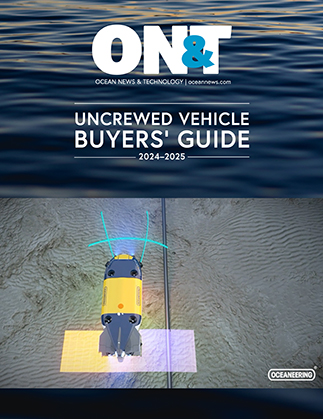Whether deploying work-, observation-, or inspection-class ROVs, most operator requests remain aligned; ROV users are increasingly looking for customizable, reliable, and cost-effective systems capable of completing a series of programmable tasks for subsea infrastructure inspections, deep-sea exploration, near and offshore aquaculture inspections, and more. In other words, they demand sustained in-field versatility, and this is slowly but surely impacting how developers consider the future utility of ROVs across the ocean sector.
FORM & FUNCTION
The pronounced uptick in interest and availability of smaller, portable observation-class ROVs is in no small part attributable to the needs voiced by research, survey, and nearshore infrastructure managers. These compact, modular units offer plug-and-play capabilities, and with ongoing investments being made to introduce additional functionality and tooling, there is a renewed excitement surrounding ROV development and application.
At a time when “doing more with less” is more a project directive than an operational goal, manufacturers are dedicating considerable resources to stretching the suitability of smaller ROVs to complement—even challenge—the tasks traditionally associated with larger sized ROV models. Across the board, from micro-ROVs to imposing, deep-water work-class units, all are unified in the mission to optimize the use of onboard space and potential payload. Frame materials, buoyancy aids, lights, cameras, power sources, propulsion systems, thrusters, teethers, and other tooling components are all subject to scrutiny when striking the right balance between form and function.
Fast emerging as a front runner in the design and production of commercial grade, portable ROVs, Deep Trekker was on the Oi24 exhibition floor, presenting their portfolio of compact, mission-ready machines, all offering flexible power options and integrated accessory add-ons. While small, these ROV packages boast powerful capabilities, providing users with stability and control in a portable package that can be deployed in a multitude of environments.
With several models on display in London, the Deep Trekker’s DGT3 ROV was an immediate draw as it flaunted its extreme moveability in a small test tank. Depth-rated to 200 m with tether options to 700 m, this lightweight, highly portable ROV with a growing menu of interchangeable add-ons is certainly a bellwether for the future of smaller systems.
ELECTRIFYING TECH
Decarbonizing remote technologies is a theme destined to endure. Like most modern-day tech, the industry is limited and controlled by one major component: the battery. While smaller, less power hungry ROV conversions to electric power sources have come with more ease, larger work-class vehicles—systems traditionally reliant on hydraulic systems for power—have had to overcome in-field challenges related to pressure at depth, heat, and reliability.
Today, the rapid evolution of electric ROVs (eROVs) is enabling offshore developers and partners to electrify their subsea toolkits. One such operator is Luxembourg-based marine operator Jan De Nul Group, who announced the acquisition of a Quantum EV ROV from SMD.
Commenting on its latest partnership with SMD, Jan Van de Velde, Director Newbuilding at Jan De Nul Group, said: “Our attention to environment and climate is mirrored in SMD’s Quantum EV, which not only offers superior efficiency and reliability but also consumes less energy and drastically reduces the risk of oil contamination.”
Also on display at Oi24, was Saab Seaeye’s eWROV. With precise, quieter, and reliable performance matching that of a 250-horsepower hydraulic vehicle, the eWROV has been designed with “eco-responsibility” in mind. Saab also featured the eManip, an all-electric-seven-function work-class manipulator characterized as being more accurate, reliable, and dexterous than its hydraulic counterparts.
Technical innovations like these continue to inspire the notion of carbon neutrality among offshore operators and offer a practical pathway to establishing sustainable, in-field practices that prioritize climate concerns without compromising the reliability and operational efficiency of more conventional hydraulic work-class ROVs.
ONBOARD CUSTOMIZATION
And it was not just complete systems on show at Oi24. Increasingly, it is what’s being added to them that demands attention. Sensors and instrument providers are ramping up their efforts to incorporate plug-and-play options for efficient and compatible monitoring and observing tasks like carbon and methane gas detection, corrosion lifetime and protections, and ocean noise measurements. Payload add-ons and sensor options for ROVs, down to the size of microchips, the types of connectors and plugs, and ease of calibration, are front-and-center considerations for ROV developers and users alike.
Sensor providers like NBOSI Ocean Sensors, another exhibitor at Oi24, are leading the charge in delivering small and rugged instrumentation for ROVs. Chip size, bulkhead connectors, and feasibility of calibration are all considerations being made by instrument and sensor companies seeking to stretch and enhance the utility of modern-day ROV platforms.
In recent years, the ROV—a stalwart of ocean explorations—has arguably been eclipsed by some of the other breaking technologies seeking to champion remote marine operations. These contenders, noticeably USVs and AUVs, were also well represented at this year’s conference and exhibition. There is a renewed excitement surrounding ROVs as the categorization within their classes continues to diversify. For ON&T, that is a tantalizing prospect as we tiptoe towards the tenth edition of our Uncrewed Vehicles Buyers Guide, to be published in July 2024.
This feature originally appeared in ON&T’s April 2024 issue. Click here to read more.

